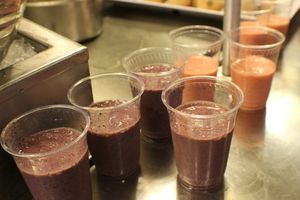July 9, 2012 at 7:56 am
By Rebecca Shrago, Dietetic Intern, Sargent College
Now that the 4th of July is behind us – the fireworks done, the cookouts over, the masses back
to work – we have officially entered the Dog Days of Summer. And as I stood in front of the air
conditioner last night, starving but absolutely unwilling to do anything involving stove or oven,
some words from Mark Bittman came to mind: “Summer may not be the best time to cook, but
it’s certainly among the best times to eat.”
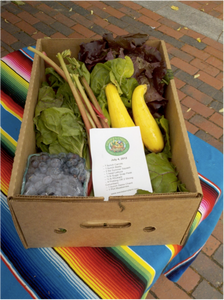
Truer words were never spoken.
In this week’s CSA box:
- Rhubarb: this fruit, which looks similar to celery, is commonly associated with sweet treats (strawberry-rhubarb pie, anyone?). Did you know, though, that rhubarb alone is tart? This is why it is commonly cooked with sugar and other sweet fruits.
- Summer Squash: Contains the carotenoids lutein and zeaxanthin, which research has
shown to be strongly implicated in eye health. Although technically a fruit, summer
squash is most often prepared as a vegetable. Try it grilled, sautéed, steamed, or
roasted.
- Blueberries: Antioxidants. Fiber. Low sugar. Delicious. Truly a nutrition all-star! Try ‘em
mixed into plain Greek yogurt with a drizzle of honey and a palmful of chopped walnuts.
- Beets: Chock-full of antioxidants, as evidenced by their brilliant color. Enjoy the sweet
and earthy flavor of roasted beets in a green salad with goat cheese and vinaigrette.
Yum!
- Carrots: Like summer squash, another excellent source of carotenoids. Feeling lazy?
Crunch these babies raw, dipping in hummus or guacamole or almond butter (trust me)
as you see necessary.
- Sugar Snap Peas: High in vitamins C and K, sweet and crunchy. Snack on them raw
alongside the carrots, or stir-fry with a little sesame oil and lite soy sauce for an Asian-inspired side.
Pickling or Slicing Cucumbers: Cooling and refreshing, with anti-inflammatory
properties. Make some raita (recipe below).
- Swiss chard: A veritable superfood – high in vitamins A, C, and K, as well as Magnesium,
- Manganese, Potassium, and Iron. These hearty greens are best steamed, braised, or
- sautéed. Add a dash of orange juice to sautéed chard – or braise in orange juice – to
- maximize iron absorption.
Cucumber Raita
Recipe adapted from The Vegetarian Epicure II by Anna Thomas
A classic Indian yogurt sauce commonly paired with spicy foods to cool the palette.
Serves 4-6
Ingredients:
1 large cucumber
2-3 tablespoons finely chopped onions
2 cups plain yogurt
¼ teaspoon ground cumin
1/8 teaspoon cayenne pepper
salt
chopped fresh cilantro
Directions:
Peel the cucumber, seed it, and coarsely grate it. Stir together the cucumber, onions, and
yogurt.
Heat the ground cumin for a moment in a small enameled pan, then remove it from the heat
and quickly stir in a little of the yogurt mixture. Return the yogurt-cumin mixture to the rest and
stir thoroughly. Stir in the cayenne, salt to taste, and add as much chopped cilantro as you like.
Awesome with curries or other Indian dishes.
By Sargent Choice Nutrition Center
|
Posted in CSA, Recipes
|
Tagged BU, CSA Box, Rebecca Shrago, Sargent Choice Nutrition Center, Vegetables, Vegetarian
|
July 7, 2012 at 10:47 pm
By Kelli Swensen, Dietetics Student, Sargent College

MIT Market Produce Stand
Similar to BU wanting to provide the community with access to local food goods, MIT’s Produce Market, run by Russo’s, offers an option for affordable, healthy fruits and vegetables. Located in Watertown, MA, Russo’s is a family-run operation that has been around for over 75 years. In addition to their high-quality produce featured at the Produce Stand, Russo’s also sells meats, cheeses, baked goods, prepared foods, and other specialty items. To find out how you can get your hands on their other food offerings, head on over to Russo’s website HERE. While you’re there, also be sure to check out their recipe page and catering service!
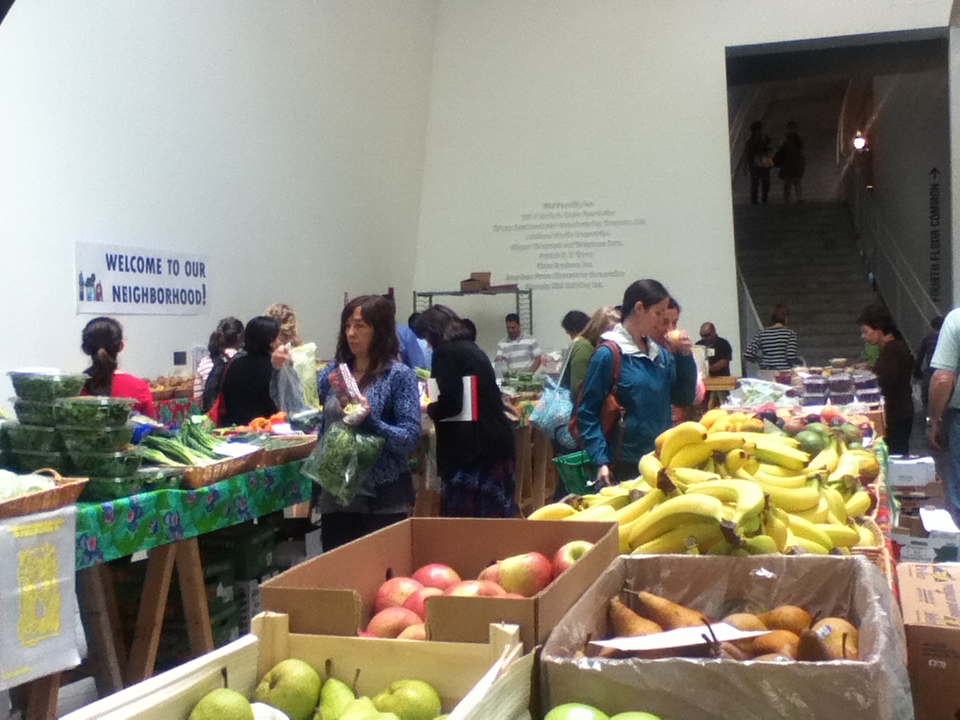
Now for the produce stand.
What You’ll Find: Affordable, high-quality fruits and vegetables all supplied by Russo’s. Russo's also lists their weekly specials for the produce market HERE.
Hours: The market is open every Tuesday from 11:00 a.m. – 5:00 p.m. and runs until December 25, 2012.
Location: Gates Lobby in the Stata Center (32 Vassar St.) in Cambridge.
Getting There: The fastest way using public transportation is to take the CT2 Bus towards Sullivan Station via Kendal/MIT and get off at Amesbury St. at Vassar St.

Pictures were taken by Sargent Choice Nutrition Center friend Mandy Luk, thanks Mandy!
By Sargent Choice Nutrition Center
|
Posted in Restaurants and Farmers Markets
|
Tagged BU, Kelli Swensen, Sargent Choice Nutrition Center
|
July 5, 2012 at 1:54 pm
By Kelli Swensen, Dietetics Student, Sargent College
 Picture Source
Picture Source
One of the great emerging trends is the push to eat local and sustainable. Here at BU,there has been tremendous effort to make our university more sustainable (for more information on exactly what BU is doing, check out BU Sustainability's comprehensive website). But what does it mean to eat locally? What exactly is sustainable? For these answers, I headed on over to SustainableTable.org, which is a wonderful resource for answering any questions you have on the topic. To summarize, local can mean eating foods you grow at home or your neighborhood farm sells. In general, local is defined as food that has to travel less than 100 miles to get to you. Sustainable agriculture, as explained by Sustainable Table, involves "food production methods that are healthy, do not harm the environment, respect workers, are humane to animals, provide fair wages to farmers, and support farming communities."
 Picture Source
Picture Source
So how do you go about shopping for sustainable foods? Sustainable Table has a great list of common sustainability terms you may come across on labels to help make shopping for sustainable foods at the supermarket easier. They also have a search engine that helps you find restaurants in your area that feature local ingredients. 
Another great option is to go to farmers markets and local produce stands. To find a market close to you, click here and type in your address. For anyone living in Boston, we here at the blog will be featuring some of these markets in posts throughout the summer. For those of you living in or around the Boston area, be sure to check out the Federation of Mass Farmers Markets to search for nearby markets by zip code or product.
By Sargent Choice Nutrition Center
|
Posted in BU Community, Nutrition News, Restaurants and Farmers Markets
|
Tagged BU, CSA Box, Kelli Swensen, Sargent Choice Nutrition Center
|
July 3, 2012 at 9:49 am
 Picture Source
Picture Source
By Kelli Swensen, Dietetics Student, Sargent College
With warm weather around the country, there is bound to be a bunch of neighborhood and family Fourth of July celebrations. Grilling is a great way to not only make delicious foods filled with summer flavors, but it is also a healthy option for preparing food. Chicken, lean meat, fish, vegetables, fruit, they all taste wonderful grilled! Below are some nutritious options for your Independence Day party:
Appetizers

Picture from Two Peas and Their Pod
Quinoa Fruit Salad with Honey Lime Dressing from Two Peas and Their Pod

Picture from A Couple Cooks
Grilled Corn with Chili-Lime Mayo from A Couple Cooks
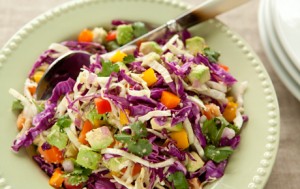
Picture from Whole Foods
Lemony Cabbage-Avocado Slaw
Mains

Picture from Naturally Ella
BBQ and Pineapple Turkey Burgers from Naturally Ella

Picture from Whole Foods
Gorgonzola and Sun-Dried Tomato Bison Burger from Whole Foods

Picture from EatLiveRun
Plant Burgers from EatLiveRun

Picture from Iowa Girl Eats
Grilled Pizza from Iowa Girl Eats
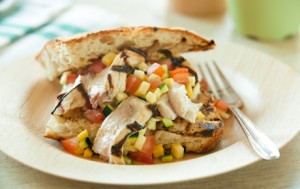
Picture from Whole Foods
Grilled Swordfish Sandwiches with Summer Squash Salsa from Whole Foods
Desserts (all prepared on the grill)

Picture from Aggies Kitchen
Grilled Banana Boats from Aggies Kitchen

Picture from Chaos in the Kitchen
Grilled Fruit Skewers from Chaos in the Kitchen
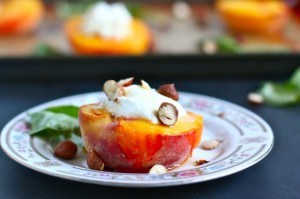
Picture from EatLiveRun
Roasted Peaches with Goat Cheese and Honey
Also be sure to check out our post on Summer-perfect Sargent Choice recipes as well as Cooking Light's list of healthy Fourth of July menu ideas.
Happy Fourth of July!
By Sargent Choice Nutrition Center
|
Posted in Recipes
|
Tagged BU, Holiday, Kelli Swensen, Sargent Choice Nutrition Center
|
June 26, 2012 at 5:22 pm
By Kelli Swensen, Dietetics Student, Sargent College

For the past year, nutrition power-house kale has gone from being hippie food to a staple supermarket find. If you read any nutrition articles either in magazines or online, I will bet that you've read about kale at least once. When I was home in Colorado last December, my mom and I went to a new buzzed about restaurant. Guess what was featured all over their menu: kale. So what's the big deal about this strange-looking leafy green? And where can you get some yourself?
Belonging to the Brassica family, Kale is related to cabbage, collards, and Brussels sprouts, all of which are known for their high density of nutrients.
Just how healthy is kale? According to Whole Foods' chart, 1 cup of cooked Kale (130.00 grams) contains almost all of your daily vitamin K, vitamin A, and vitamin C; along with a significant amount of your daily manganese. If you're not impressed then think of this: 1 cup of cooked kale contains all of those nutrients for only 36 calories.
To get the most flavor and nutrition out of kale, you should first rinse it under cold water, sprinkle it with lemon juice and then let it sit for 5 minutes. We recommend the cooking kale by steaming it for 5 minutes in a steamer pot.
Be sure to check out 101 Cookbooks' list of Kale Recipes

Picture from FarmtoTableOnline.org
This week's CSA box contains Red Russian Kale, which has a milder taste and is less bitter than other varieties, making it the perfect way to introduce kale into your diet!
What else is in the box:
- 1 lb. Green or Wax Beans
- 1 bunch Carrots
- 1 bunch Red Russian Kale
- 1 bunch Spinach
- 1.5 lbs. Shell Peas
- 2 lbs. Squash
- 1/2 pint Blueberries
- 1 bunch Beets

Picture from Kayln's Kitchen
Red Russian Kale and Red Onion Savory Breakfast Squares
Adapted from Kayln's Kitchen
Ingredients:
- 1 bunch Red Russian Kale, chopped
- 1/2 red onion
- 2 cloves garlic, minced
- 1/2tsp olive oil
- 1 tsp soy sauce
- 1 cup low-fat cheese (such as mozzarella or provolone)
- 6 eggs, well beaten
- Pinch salt and pepper
- Optional: 1/4 cup 100% whole wheat bread crumbs
Directions:
- Preheat oven to 350. Cut off kale stems and wash kale leaves. Dry well. Pile kale leaves and cut into strips about 3/4 inch wide, then cut the other way to create squares. Chop onion pieces about 1/2 inch
- Heat olive oil in large frying pan, then add onions and saute for 3 minutes. Add garlic, sauteing for 2 more minutes, then add kale and saute for 5 minutes until kale is wilted and softened.
- Place sauteed vegetables into large bowl and add soy sauce, cheese, bread crumbs (if using), beaten eggs, and seasonings. Stir gently until ingredients are well combined. Spray pan with olive oil or nonstick spray and pour in egg mixture. Bake 20-25 minutes until eggs are well set and the top is slightly browned
By Sargent Choice Nutrition Center
|
Posted in CSA
|
Tagged BU, CSA Box, Kelli Swensen, Sargent Choice Nutrition Center, Vegetables
|
June 21, 2012 at 1:08 am
By Clara Gordon, Dietetic Intern, Sargent Choice Nutrition Center
Snacking can be an important nutrition strategy for anyone seeking to maintain adequate energy throughout their day. In the popular press, snacking, grazing, or any other word denoting an occasion to nosh between meals has fallen in and out of vogue depending upon the latest dietary crazes. Trends aside, mindful and planned snacking will always hold valuable potential to keep you happy, satisfied, and well-fueled for the day’s endeavors.
One of the best times to reach for a snack is prior to exercise. Many people work out in the afternoon following class or work. This window of time provides an excellent opportunity to commune with friends at a fitness class, stretch your muscles and blow out their proverbial “cobwebs,” or just unwind with your iPod. Consuming a smart snack (see details below!) in the 1-2 hours prior to exercise will help you feel your best when you commence more strenuous activity. Plus, beginning your workout with adequate energy at your immediate disposal will help you conclude your session in better shape to make food-related decisions for the rest of the day as well.
An optimal blend of pre-exercise fuel is comprised of approximately 2/3 carbohydrate to 1/3 lean protein. All of these principles are listed here in the Nutrition and Fitness Center’s guide to Smart Snacking. The number of calories in the snack will be dictated by your individual needs for the day as well as the anticipated duration and intensity of the exercise you will perform. As a ballpark figure, 150-300 calories offers a strong nutritional platform for a solid workout.
Below are specific snack suggestions based upon snacks you can drop into your bag in the morning and consume later, and snacks that should be kept with an icepack or purchased at the time you wish to eat.
Backpack-Ready:
- Half a peanut butter and jelly sandwich
- Kashi TLC granola bar and a piece of fruit
- Nature Valley granola bar and a tablespoon of almond butter
- 1/2 cup homemade dried fruit and nut mixture (1/4 cup each)
Store with an icepack or pick up along the way:
- Sabra pretzel and hummus snack cup
- Sargent Choice fruit and yogurt parfait
- Low-fat chocolate milk
- Tuna fish with whole grain crackers
- Pasta salad with vegetables and beans
- Starbucks oatmeal with fruit and nut mixture
- Laughing Cow cheese with whole grain crackers
- Half a turkey sandwich on a whole wheat pita
- Non-fat Greek yogurt and a piece of fruit
- Low-fat cottage cheese and pineapple or peaches in juice
- Plain yogurt packed with frozen berries
- Wasa Bread with low-fat cream cheese spread and thin fruit or veggie slices

Snacking is a strategy whose rewards are immediate and sustained. Snacking prior to workout also helps you make smarter, more sensible food choices after you are through exercising. Have you ever shuffled out of the gym in a hungry stupor only to devour whatever brightly packaged drink or dubiously healthy granola bar you encounter first? That’s okay: We’ve all been there. However, there is a better way to honor your daily fitness accomplishments by concluding the day’s meals on a nutrition high note. That path begins with strategic snacking. Just like sports and fitness, practice makes perfect, and doing it daily can contribute to lifelong well-being.
What are your favorite pre-workout snacks?
By Sargent Choice Nutrition Center
|
Posted in exercise
|
Tagged BU, Clara Gordon, Fitness, Nutrition Tips, Sargent Choice Nutrition Center
|
June 18, 2012 at 6:23 pm
By Kelli Swensen, Dietetics Student, Sargent College

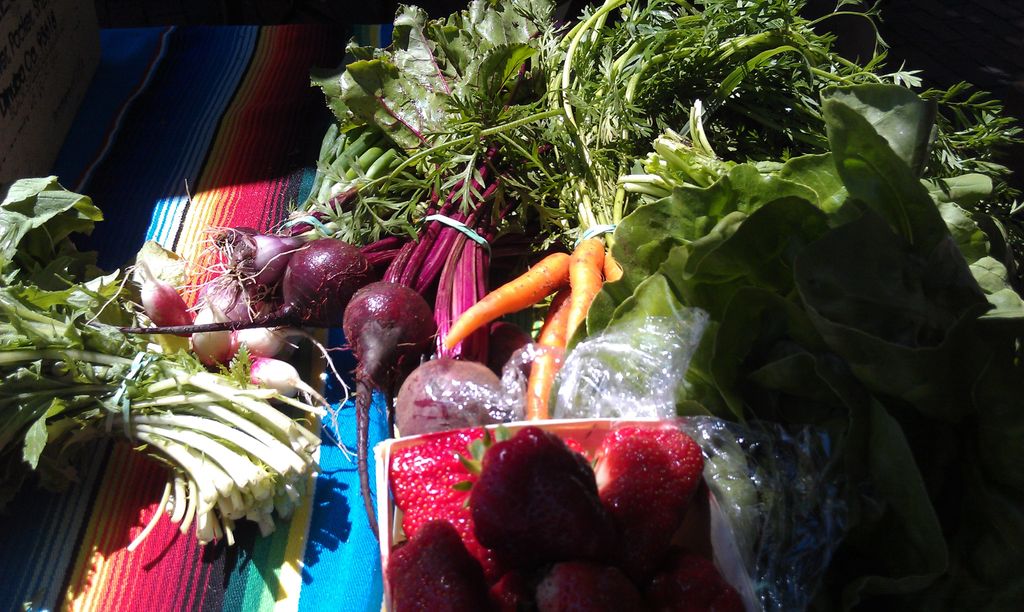
If these pictures fill you with food envy check out last week’s post on how to get in on the summer CSA boxes! Despite the slightly chilly weather, the strawberries in last week’s CSA box made for a sweet start to the weekend. As I'm sure you've already devoured the berries, I'm happy to inform you that this week's CSA box will contain more of those red, juicy summer fruits!
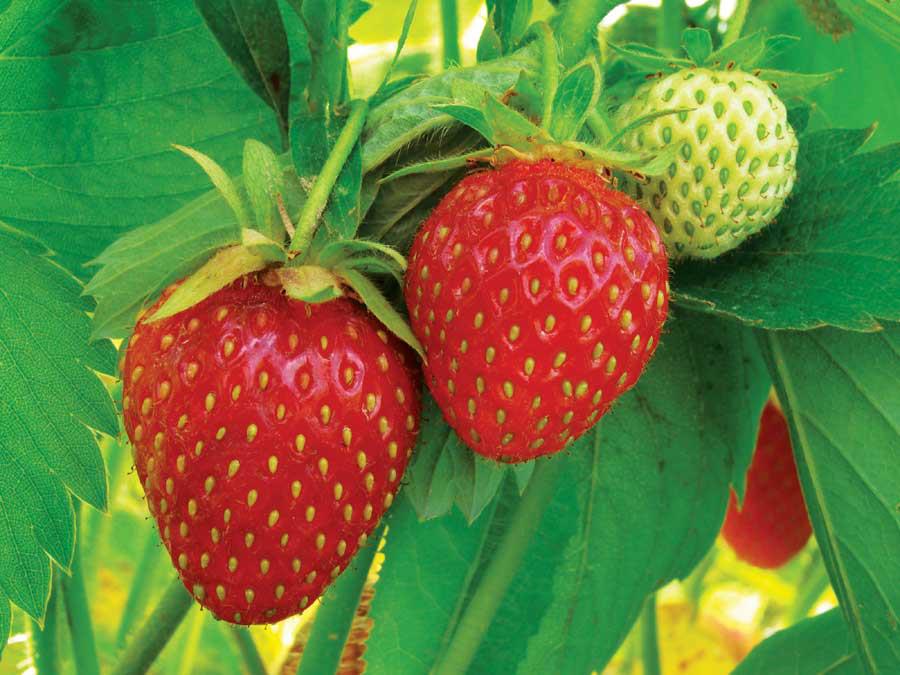
What to look forward to Thursday:
- 1 quart Strawberries
- 1 bunch Radishes
- 1 bunch Carrots
- 1 lb. Sugar Snap Peas
- 1 bunch Beets
- 1 bunch Tatsoi
- 1 bunch Red Mustard Greens
- 1 lb. Shell Peas

For any of you who, like me, have never heard of tatsoi, no need to worry: I researched this exotic-sounding vegetable and found that it not only sounds delicious, but will be easy to incorporate into your meals. Tatsoi is a traditional Chinese salad green, with a mustard-like flavor and a texture strongly resembling bok choy. In fact, if you have a recipe in which you use bok choy, you can easily substitute in the tatsoi. A cool fact about tatsoi is that is can be harvested under snow in cold climates. Try adding this cold-resistant green to your favorite salad, stir-fry, or soup this week!

Tatsoi and Sweet-Corn Salad With Peach-Nectar Dressing
(Recipe from New York Times)
Serves 6
Ingredients
- 2 tablespoons canola oil
- 2 peaches, peeled and diced
- 3 ears fresh sweet corn, husked
- 8 cups tatsoi greens, or other tender mild greens
- 3/4 teaspoon coarse sea salt
- Freshly squeezed lemon juice to taste
Preparation
1. In a skillet set over medium heat, heat the oil. Add the peaches and cook, stirring occasionally, until very soft, about 20 minutes. Set aside to cool.
2. Meanwhile, bring an inch of salted water to a boil in a large pot. Add the corn and steam 5 minutes. Drain the corn and allow to cool. Using a knife, scrape the kernels off the cobs and place the kernels in a large bowl.
3. Just before serving, add the tatsoi, peaches and salt, and toss well. Season to taste with lemon juice, toss again and serve.
By Sargent Choice Nutrition Center
|
Posted in CSA
|
Tagged BU, CSA Box, Kelli Swensen, Sargent Choice Nutrition Center, Vegetables, Vegetarian
|
June 5, 2012 at 9:10 am
By Kelli Swensen, Dietetics Student, Sargent College
The first Tuesday of every month we will be featuring a grain. The posts will include background on the grain, nutritional information, instructions on how to store and cook it, and, of course, one or two healthy recipes for using the grain. Our goal is to help you add variety to your meals in 2012!

Background:
Famously know as an ingredient in beer, whole grain barley is also a versatile grain that adds a nutty flavor and a chewy, pasta-like texture to a dish.
Nutritional Profile:
Whole grain barley’s spotlight nutritional benefit is it is an excellent source of fiber and selenium. It is also a good source of phosphorus, copper, and manganese.
Buying and Storing:
Like many grains, there are numerous types of barley and not all of them are whole grains. There are three general types of barley: pearl, hulled (sometimes called “dehulled”), hulless and pot. Hulled and hulless barely are both considered whole grains and have only had the hull, the inedible portion, removed. Pearl and pot barley are not whole grains. Many companies have made it even easier to decipher which variety to choose from by stating “whole grain” on the package.
To store barley, keep it in a glass container in a cool, dry place. If your kitchen tends to get humid and hot during the summer, it is a good idea to store your barley in the fridge.
Preparing:
Before cooking, make sure to rinse the barley under the sink to remove any debris. The general rule for cooking barley is one part barley to three and a half parts of boiling water or low-sodium broth. After adding the barley, bring back to a boil, turn down the heat, cover the pot, and simmer for about 90 minutes.
Recipes:
By Sargent Choice Nutrition Center
|
Posted in Grain of the Month
|
Tagged BU, Grain of the Month, Kelli Swensen, Sargent Choice Nutrition Center
|
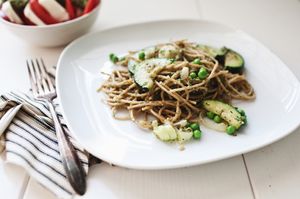 Picture from The Little Red House
Picture from The Little Red House Picture from Naturally Ella
Picture from Naturally Ella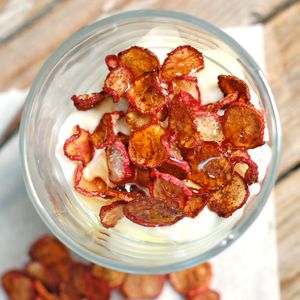 Picture from Pinch of Yum
Picture from Pinch of Yum